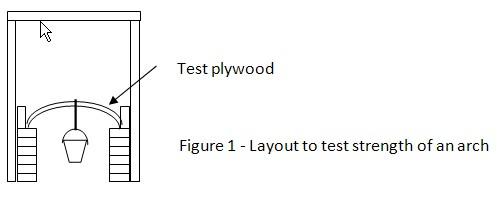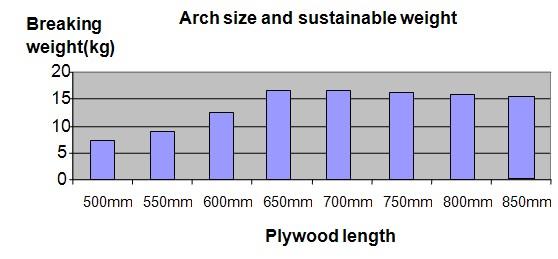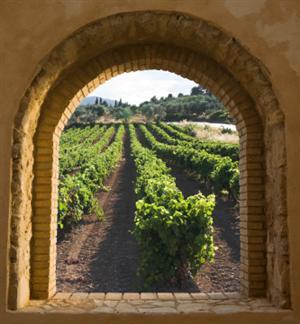| Complexity level: | 6 |
| Project cost ($): | 70 |
| Time required: | 1 day for preparation 1 day for science fair project |
| Material availability: | May be obtained from a hardware store |
| Safety concerns: | Sawing should be performed by an adult wearing proper safety gear. |
Hypothesis
A larger arch is able to withstand a heavier load.
Overview
Arch
Arches are semicircle structures supported at both ends. Arch structures are used in the construction of entrances, windows and bridges.
The building of an arch will normally start with a wooden frame that will support the underside of the arch. Scaffolding is normally used together with the wooden frame for taller arches. The main component of the arch will be the keystone which is located in the middle and at the highest point of the arch An arch which is not build properly will collapse when the frame is being removed.
Most materials that are used in the construction of arches are weak under tensile stress but they are strong in withstanding compressive stress. Such materials are concrete, stone, iron and wood. The design of an arch is such that it is able to minimize tensile stress . and withstand as much compressive stress as possible.
Scientific Terms
Materials
The materials required for this science fair project are:
- 4 plywood sheets (1 meter x 1 meter)
- 1 large pail
- Tap water
- 1 weighing machine
- 2 fixed pillars 500 mm apart
- 1 saw
- 1 ruler
- 14 bricks (add more bricks as required)
- 1 marker pen
Procedure
1. The independent variable of this science fair project is the length of the arch. The dependent variable is the amount of weight place on the arch before it breaks. This is determined by measuring the weight of the load using the weighing machine. The constants (control variables) are the distance between the pillar, the type of wood used and the dimension (width and thickness) of the wood.
2. Cut the plywood into smaller pieces, of width 100 mm. Cut 4 pieces of plywood into the following lengths – 500mm, 550mm, 600mm, 650mm, 700mm, 750mm, 800mm and 850mm. Draw a line at the center of the plywood.
3. Two pillars 500mm apart are used as a test table. See figure 1 below. Such a pillar can also be created by arranging the bricks on the sides of a door as shown in figure 1.

4. Position the 500mm peice of plywood as shown in figure 1 Hang the pail on the plywoodwith a string. Use the line marked earlier as a guide for the center. Add water to the pail until the plywood breaks. Record the final volume of the water used.
5. Repeat step 4 on the remaining 7 sizes of plywood. Record the measurements in the table provided below.


Results
The strength of the arch peaks at a plywood length of 650mm I don’t understand what this means.
| Plywood length | Weight applied to the plywood arch before it breaks | |||||||
| 500mm | 550mm | 600mm | 650mm | 700mm | 750mm | 800mm | 850mm | |
| Weight (kg) | 7.3 | 8.9 | 12.4 | 16.5 | 16.4 | 16.2 | 15.9 | 15.5 |
The graph below represents the results of our experiment

Conclusion
The hypothesis that larger arches are able to withstand a heavier load is proven to be true to a certain extent only. As the curve of the arch increases, so does the surface tension on the upper surface of the plywood, leading to breakage.
Arches have been used in construction since the 2nd millennium BC by the Mesopotamians. Ancient arch bridges built by the Romans are still structurally sound and some of them are still standing today.
Also consider
The science fair project can be repeated by varying the type of wood used.
The experiment can be repeated by varying the width of the plywood used.
References
Arch - http://en.wikipedia.org/wiki/Arch
How bridges work? - http://science.howstuffworks.com/bridge6.htm

